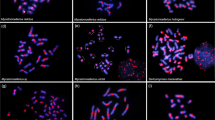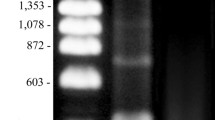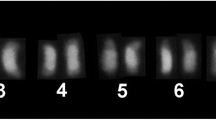Abstract
Chromosomal localization of rDNA in samples of five taxa of the Myrmecia pilosula species complex (Hymeoptera: Formicidae: Myrmeciinae) with 2n=3 (M. croslandi), 8 (M. imaii), 10 (M. banksi), 18 (M. haskinsorum), and 27 (M. pilosula) was carried out by fluorescence in situ hybridization (FISH) using cloned M. croslandi rDNA (pMc.r2) including the coding region for 28S rRNA. Results show that (1) the 28S rDNA in the genome of these ants is repetitive and is localized in pericentromeric C-bands, (2) the number of chromosomes carrying rDNA is two in M. croslandi, M. imaii and M. banksi, six in M. haskinsorum and ten in M. pilosula, and (3) only one or two clusters of rRNA genes generate nucleoli in each species. We suggest that the rDNA in the ancestral stock of the M. pilosula complex was localized originally in a pericentromeric C-band, and multiplied by chance with time during saltatory increases in C-banding following episodes of centric fission. Most rDNA multiplied on various chromosomes seems to be inactivated and eliminated from the genome, together with C-bands, by \({\text{A}}\overline {\text{M}} \)-inversion or centric fusion, with the remnant rDNAs dispersed in the genome by centric fission and \({\text{A}}\overline {\text{M}} \)-inversion.
Similar content being viewed by others
References
Babu KA, Verma RS (1985) Structural and functional aspects of nucleolar organizer regions (NORs) of human chromosomes. Int Rev Cytol 94: 151–176
Babu KA, Verma RS (1987) Chromosome structure: Euchromatin and heterochromatin. Int Rev Cytol 108: 1–60
Blackburn EH (1991) Structure and function of telomeres. Nature 350: 569–573
Church GM, Gilbert W (1984) Genomic sequencing. Proc Natl Acad Sci USA 81: 1991–1995
Doolittle WF, Sapienza A (1980) Selfish genes, the phenotype paradigm and genome evolution. Nature 284: 601–603
Endow SA (1982) Polytenization of the ribosomal genes on the X and Y chromosomes of Drosophila melanogaster. Genetics 100: 375–385
Goessens G (1984) Nucleolar structure. Int Rev Cytol 87: 107–158
Goodpasture C, Bloom SE (1975) Visualization of nucleolar organizer regions in mammalian chromosomes using silver staining. Chromosoma 53: 37–50
Gosden J, Lawrie S, Seuanez H (1978) Ribosomal and human-homologous repeated DNA distribution in the orangutan (Pongo pygumaeus). Comparison with the distribution of these DNAs in the other species of the Hominidae. Cytogenet Cell Genet 21: 1–10
Greider CW, Autexier C, Avilion AA, Collins K, Harrington LA, Mantell LL, Prowse KR, Smith SK, Allsopp RC, Counter CM, Vaziri H, Bacchetti S, Harley CB (1993) Telomeres and telomerase: biochemistry and regulation in senescence and immortalization. In: Heslop-Harrison JS, Flavell RB (eds) The chromosome. Bios Scientific Publisher, Oxford, pp 115–125
Hadjiolov AA (1985) The nucleolus and ribosome biogenesis. Springer, Wien
Hagemann S, Scheer B, Schweizer D (1993) Repetitive sequences in the genome of Anemone blanda: Identification of tandem arrays and of dispersed repeats. Chromosoma 102: 312–324
Henderson AS, Warburton D, Megraw-Ripley S, Atwood KC (1977) The chromosomal location of rDNA in selected lower primates. Cytogenet Cell Genet 19: 281–302
Hirai H, Spotila LD, LoVerde PT (1989) Schistosoma mansoni: Chromosomal localization of DNA repeat elements by in situ hybridization using biotinylated DNA probes. Exp Parasitol 69: 175–188
Howell WM, Black DA (1980) Controlled silver-staining of nucleolus organizer regions with a protective colloidal developer: a 1-step method. Experientia 36: 1014–1015
Imai HT (1991) Mutability of constitutive heterochromatin (C-bands) during eukaryotic chromosomal evolution and their cytological meaning. Jpn J Genet 66: 635–661
Imai HT, Crozier RH (1980) Quantitative analysis of directionality in mammalian karyotype evolution. Am Nat 116: 537–569
Imai HT, Maruyama T (1978) Karyotype evolution by pericentric inversion as a stochastic process. J Theor Biol 70: 253–261
Imai HT, Taylor RW (1989) Chromosomal polymorphisms involving telomere fusion, centromeric inactivation and centromere shift in the ant Myrmecia (pilosula) n=1. Chromosoma 98: 456–460
Imai HT, Maruyama T, Gojobori T, Inoue Y, Crozier RH (1986) Theoretical bases for karyotype evolution. 1. The minimum interaction hypothesis. Am Nat 128: 900–920
Imai HT, Taylor RW, Crosland MWJ, Crozier RH (1988) Modes of spontaneous chromosomal mutation and karyotype evolution in ants with reference to the minimum interaction hypothesis. Jpn J Genet 63: 159–185
Imai HT, Hirai H, Satta Y, Shiroishi T, Yamada M, Taylor RW (1992) Phase specific Ag-staining of nucleolar organizer region (NORs) and kinetochores in the Australian ant Myrmecia croslandi. Jpn J Genet 76: 437–447
Imai HT, Taylor RW, Crozier RH (1994) Experimental bases for the minimum interaction theory. 1. Chromosome evolution in the ant Myrmecia pilosula species complex. Jpn J Genet, in press
King M, Contreras N, Honeycutt RL (1990) Variation within and between nucleolar organizer regions in Australian hylid frogs (Anura) shown by 18S+28S in situ hybridization. Genetica 80: 17–29
Knibiehler B, Mirre C, Rosset R (1982) Nucleolar organizer structure and activity in a nucleolus without fibrillar centers: The nucleolus in an established Drosophila cell line. J Cell Sci 57: 351–364
Lohe AR, Roberts PA (1990) An unusual Y chromosome of Drosophila simulans carrying amplified rDNA spacer without rDNA genes. Genetics 125: 399–406
Long EO, Dawid IB (1980) Repeated genes in eukaryotes. Annu Rev Biochem 49: 727–764
Maluszynska J, Schweizer D (1989) Ribosomal RNA genes in B chromosomes of Crepis capillaris detected by non-radioactive in situ hybridization. Heredity 62: 59–65
Orgel LE, Crick FH (1980) Selfish DNA: the ultimate parasite. Nature 284: 604–607
Pendas AM, Morán P, Garsía-Vázquez E (1993) Multi-chromosomal location of ribosomal RNA genes and heterochromatin association in brown trout. Chrom Res 1: 63–67
Richards EJ, Vongs A, Walsh M, Yang J, Chao S (1993) Substructure of telomere repeat arrays. In: Heslop-Harrison JS, Flavell RB (ed) The chromosome. Bios Scientific Publisher, Oxford, pp 115–125
Schwarzacher T, Mayr B, Schweizer D (1984) Heterochromatin and nucleolus-organizer-region behaviour at male pachytene of Sus scrofa domestica. Chromosoma 91: 12–19
Short JM, Fernandes JM, Sorge JA, Huse WD (1988) ZAP: A bacteriophage expression vector with in vivo excision properties. Nucleic Acids Res 16: 7583–7600
Summer AT (1990) Chromosome banding, Unwin Hyman, London
Suzuki H, Sakurai S, Nishimura M, Kominami R, Moriwaki K (1992) Compensatory changes in silver-stainability of nucleolar organizer regions in mice. Jpn J Genet 67: 217–232
Author information
Authors and Affiliations
Rights and permissions
About this article
Cite this article
Hirai, H., Yamamoto, MT., Ogura, K. et al. Multiplication of 28S rDNA and NOR activity in chromosome evolution among ants of the Myrmecia pilosula species complex. Chromosoma 103, 171–178 (1994). https://doi.org/10.1007/BF00368009
Received:
Revised:
Accepted:
Issue Date:
DOI: https://doi.org/10.1007/BF00368009




